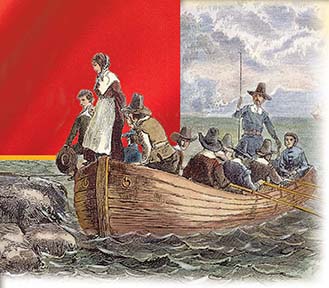SECTION 4: The New England Colonies

▲ Settlers land at Plymouth Rock
WITNESS HISTORY  AUDIO
AUDIO
The Pilgrims Leave for America
John Robinson, a Puritan pastor, addressed the Puritans who were about to sail to America on the Mayflower. Robinson spoke to them about how they should choose those who would govern them. He told the Puritans:
“… whereas you are become a body politic, using amongst yourselves civil government, and are not furnished with any persons of special eminency above the rest, to be chosen by you into office of government; let your wisdom and godliness appear, not only in choosing such persons as do entirely love and will promote the common good, but also in yielding unto them all due honor and obedience in their lawful administrations….”
—John Robinson, August 5, 1620
Objectives
- Discuss why the Pilgrims left England and why they signed the Mayflower Compact.
- Summarize the government and society in the Massachusetts Bay Colony.
- Explain why Rhode Island, Connecticut, and New Hampshire were founded.
- Analyze the relationship between New Englanders and Native Americans.
Terms and People
- Puritan
- Separatist
- Pilgrim
- Mayflower Compact
- John Winthrop
- Roger Williams
- Anne Hutchinson
- Pequot War
- King Philip’s War
- Metacom
NoteTaking
Reading Skill: Recognize Multiple Causes Create a chart to identify the reasons the Pilgrims left Europe.

Why It Matters Far to the north of the Southern Colonies, the English founded another set of colonies during the 1600s. New England was a land of dense forests, rolling hills, and a short growing season. New England demanded hard labor to farm and offered little prospect of getting rich. Before long, however, trade and commerce would bring prosperity to New England. Section Focus Question: What were the goals of the Plymouth and Massachusetts Bay colonies?
Puritans and the Church of England
Most of the New England colonists were religious dissidents who disagreed with the established church. Known as Puritans, they wanted to purify the Church of England, or Anglican Church, the only official and legal church in that kingdom. The Puritans believed that the Anglican Church, although Protestant, retained too many ceremonies from the Catholic Church. And a Catholic-style hierarchy of bishops controlled the local congregations. While some Puritans sought to reform the Anglican Church, others known as Separatists began their own churches.
Puritan Beliefs and Values
The Puritans followed the teachings of the theologian John Calvin. They believed that they could prepare for God’s saving grace by leading moral lives, praying devoutly, reading the Bible, and heeding their ministers’ sermons. But not even the most devout could claim salvation as a right and a certainty, for they believed God alone determined who was saved. Salvation depended on the will of God rather than good behavior or adherence to church rules.




